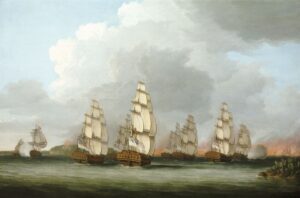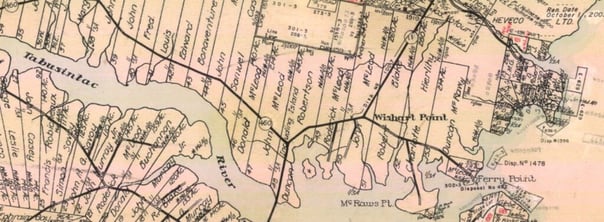 Destruction of the American Fleet at Penobscot Bay, 1779. Courtesy of the National Maritime Museum, London
Destruction of the American Fleet at Penobscot Bay, 1779. Courtesy of the National Maritime Museum, London
As the branches on my paternal grandmother’s family tree grew, they filled in with names like Hierlihy, Urquhart, and Milliken, and I was quite intrigued to discover that I had a Loyalist ancestor, a gentleman named Benjamin Milliken. He was born in Boston in 1728 to Justice Edward Milliken and Abigail Norman; settled in Hancock County, Maine (then still Massachusetts) during the Revolutionary War; and then went to St. Andrews in Charlotte County, New Brunswick. He married three times and fathered eighteen children over thirty-five years.
I have always felt a connection to Atlantic Canada and have travelled there on many occasions over a period of twenty-five years. It has always impressed me as being a lot like my native New England, which could have been some of the appeal – along with the interconnected history, magnificent scenery, and wonderful people – but then I discovered that my maternal great-grandmother had been born in Moncton, New Brunswick, and that her Acadian ancestors had been among the pioneer settlers of New Brunswick after being expelled from their lands in Nova Scotia in the mid-eighteenth century. Now, with ancestral roots, my affection for Atlantic Canada took on an added meaning. Had it been in my DNA all along to love this place? Over time, my connections to New Brunswick continued to grow, this time through my great-grandmother, Nina Isabella Hierlihy.
Back to Benjamin Milliken. As I researched him, I stumbled upon the United Empire Loyalists’ Association of Canada (UELAC) site and saw that he is a proven Loyalist, having served as a pilot on British ships. Attached to the information page on the Loyalists’ website was a loyalist certificate application submitted not too many years ago by an individual whose surname I recognized because it connects indirectly to my family branches. This applicant and I have common ancestors, William Urquhart (1777-1861) and Margaret Milliken (1777-1866). Their daughter Louisa Urquhart (1803-1885) had married James William Hierlihy (1791-1868). (They were my grandmother Vivienne Wing Whorf’s great-grandparents.) I was delighted that some of the heavy genealogical lifting had already been done, and so I considered preparing my Benjamin Milliken lineage application for membership.
I was delighted that some of the heavy genealogical lifting had already been done...
What I like about preparing lineage applications is that they force you to start at the beginning, to reconnect the dots and “remake the case” so to speak, confirming that your ancestor is, in fact, your ancestor and that he or she does indeed have the credentials to be a member of the club, be it the Mayflower Society, the Jamestowne Society, the Loyalists’ Association, or the DAR. That work is made all the easier when the ancestor’s credentials have already been established and someone has applied to the organization through him or her. Then it’s just a matter of proving one’s own ancestral relationship. I was one step ahead with Benjamin having already been verified as a Loyalist.
I began to gather the documentation needed to prove my descent from Benjamin Milliken through his daughter Margaret, my great-great-great-great-grandmother. But a funny thing happened along the way. Margaret Milliken didn’t seem to be the daughter of Benjamin and his third wife Phebe Jordan; rather she was the daughter of Benjamin’s younger brother Lemuel (1745-1839) and his wife Phebe Lord. I assumed that as the “proof” of Margaret’s relationship to Benjamin appeared to be well-documented in the application on the Loyalists’ website, I must have missed something, so I carefully retraced my tracks. Despite a dearth of vital records, all the circumstantial evidence seemed to indicate that Margaret was, indeed, one of at least seven children born to Lemuel and Phebe who had been married on 18 January 1770.
My Loyalist prospects thus dashed, I was initially disappointed but then somewhat relieved. With my fair share of Patriot ancestors of whom I am rightfully proud, did I really want to start playing for the other side? Was I being a traitor to the cause of American Independence to even consider submitting an application to the Loyalist Association? Could I ever be as proud of Benjamin Milliken as I am of Corporal Aaron Osborne, Private Joel Marshall, and Lieutenant James Puffer, all of whom marched on the Lexington Alarm? Or seafarer Joseph Homan, a member of Glover’s Marblehead Regiment who was taken prisoner? Could I ever appreciate and understand Benjamin’s conscience and choice as I did the motivation and idealism of James, Joel, Aaron, and Joseph? And how would I ever explain myself to my Patriot ancestors when I meet them in the next realm? Genealogy seemed to have saved me from an unwelcome family reunion. Or had it?
*
While untangling the Millikens, I was delighted to discover that Benjamin’s brother Lemuel, my great-great-great-great-great-grandfather, was also a Revolutionary War soldier, serving the “rebel” cause from May to December 1775 as a sergeant in Colonel Edmund Phinney’s Massachusetts Regiment and from July to September 1779 as 2nd Lieutenant in Colonel Jonathan Mitchell’s Cumberland County Regiment on what became known as the Bagaduce Expedition (or the Expedition to the Penobscot). Also serving during the ill-fated expedition, designed to dislodge the British from what is now Castine, Maine, was Lieut. Colonel Paul Revere.
Immersed in these Canadian ancestors, I returned to the daughter of William Urquhart and Margaret Milliken, Louisa Urquhart, and to her husband James William Hierlihy. Over the years I’ve chipped away at this line, hoping to learn more about my great-grandmother, Nina Isabella Hierlihy, who was the granddaughter of James and Louisa. Nina, born on Prince Edward Island, died young, at only fifty-five years of age in 1936. My Dad, born in 1927, remembered her thick Irish brogue and her visits, first to the family home in Brookline and later to Provincetown after my grandparents, John and Vivienne (Nina’s only child), had relocated to the Cape.
In a previous post about this side of the family, I mentioned that upon Nina’s death my great-grandfather, Artemas Warde Wing, remarried a woman named Rosalie who was just a few years younger than my grandmother. There was no love lost between my grandmother and her “step-mother,” who chose to not include my grandmother (the only child, too, of Artemas) in the obituary prepared for Artemas when he died in 1964. Apparently, Nina Hierlihy was rarely, if ever, discussed after Artemas remarried and so she became something of a mystery to my father, whose only memory of her seemed to be her tiny stature and unmistakable voice. That void made me want to learn more.
It took me a while to sort through the surname spellings and what seemed to be discrepancies as to where the family was from, Nova Scotia or Prince Edward Island, but once I did, I was delighted to learn of the Hierlihy connection to a fascinating and feisty woman named Charlotte Taylor who survived three husbands, the last of whom was Ireland-born Philip Hierlihy (1749-1802), my great-great-great-great-grandfather.
*
I’m still trying to learn more about Philip’s early years in Ireland, but it seems his family, the head of which was possibly Cornelius Hierlihy, emigrated to Middletown, Connecticut when Philip was a young boy, sometime around 1753. Some genealogists suggest that his older brother was the well-known Loyalist Timothy Hierlihy (1734-1797), a British officer who served in the Prince of Wales American Regiment during the Revolutionary War. After the war, he became the first British settler of Antigonish, Nova Scotia.
Also serving as a sergeant in the Prince of Wales American Regiment was Philip Hierlihy, who, as a Loyalist, came to the New Brunswick wilderness post-war with thousands of others in 1783 when it was still part of Nova Scotia and administered from Halifax. The following year, because of the influx in settlers, New Brunswick was set off as its own province.
 Cadastral map, Provincial Archives New Brunswick, showing the Hierlihy land grant on the Miramichi River (Loggieville).
Cadastral map, Provincial Archives New Brunswick, showing the Hierlihy land grant on the Miramichi River (Loggieville).
It was at Miramichi, in September 1787, that Hierlihy married the recently widowed Charlotte Taylor, said to have been the third English settler on the Miramichi and then the mother of five young children.[1] For his Revolutionary War service and after applying for numerous land grants, Hierlihy received his first in 1793. In 1798, Hierlihy and others received a grant from the Crown totaling 1,214 acres along the Miramichi River. Lots 8, 9, and 10 (in the area of Black Brook, now Loggieville) were assigned to Charlotte, Philip, and John Blake, Jr., Charlotte’s son from her marriage to Captain John Blake. Some accounts claim that these lots had originally been granted to Captain Blake, who died before 1785, though his ownership was never formalized until Charlotte fought for that recognition.[2]
 Cadastral map, Provincial Archives New Brunswick, showing the Hierlihy land grant on the Tabusintac River (Wishart Point).
Cadastral map, Provincial Archives New Brunswick, showing the Hierlihy land grant on the Tabusintac River (Wishart Point).
By all accounts, Philip Hierlihy was active in community affairs, serving on juries and as a surveyor of roads, though records indicate that there were a few small skirmishes on the wrong side of the law. Between 1788 and 1796, five children were born to Philip and Charlotte at Miramichi, but no sooner had they received their grant in 1798 when they packed up their ten children and led a small group thirty miles north, founding the community of Tabusintac, the first English settlement on the river where only a few Acadian families were then occupying the land. There they farmed and fished at what is now Wishart’s Point. Sadly, by 1804, on a map drawn by British army officer and surveyor, Dugald Campbell, Charlotte Taylor is identified as a widow. It is believed that Philip Hierlihy died in a boating accident sometime around 1802 and was buried in Bartibog along the Miramichi. Charlotte, the “Mother of Tabusintac,” lived until 1840 and is buried in Tabusintac Cemetery.
So, after navigating all these family lines it turns out that I do, after all, have a Loyalist ancestor, Philip Hierlihy, for whom I plan to submit documentation to UELAC. And though the lineage documentation is largely circumstantial, I’m also preparing a DAR application for Lemuel Milliken, who has not yet had a descendant claim him as an ancestor, though another brother, Lieut. Edward Milliken, has. I’ve decided not to dwell on my divided loyalties, but oh! how I would love to be a fly on the wall when the Milliken brothers get together.
Notes
[1] Some accounts claim that Charlotte never actually married her second husband, William Wishart, with whom she had a son, William, born in 1786.
[2] Captain John Blake, an “old settler,” may have been on the Miramichi as early as 1777. There is the suggestion that Black Brook is a corruption of Blake’s.
Share this:

About Amy Whorf McGuiggan
Amy Whorf McGuiggan recently published Finding Emma: My Search For the Family My Grandfather Never Knew; she is also the author of My Provincetown: Memories of a Cape Cod Childhood; Christmas in New England; and Take Me Out to the Ball Game: The Story of the Sensational Baseball Song. Past projects have included curating, researching, and writing the exhibition Forgotten Port: Provincetown’s Whaling Heritage (for the Pilgrim Monument and Provincetown Museum) and Albert Edel: Moments in Time, Pictures of Place (for the Provincetown Art Association and Museum).View all posts by Amy Whorf McGuiggan →